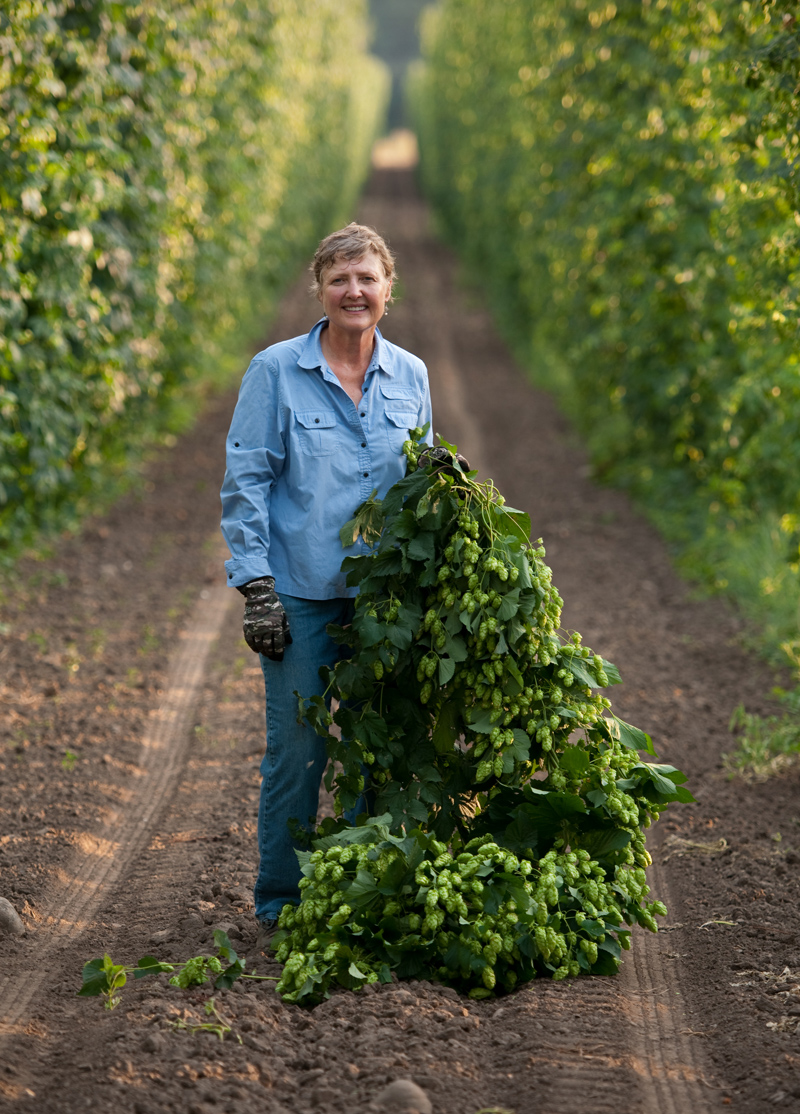The tweet contains just enough truth that it clearly makes Jason Perrault uncomfortable. Lagunitas Brewing Co. founder Tony Magee, @lagunitasT on Twitter, wrote: “Who would u guess 2 be the most important person in US craft brewing? A brewer..? Think again. He’s a Hop grower named Jason Perrault! Word.”
Magee often posts provocative statements, and Perrault characterized this one as one of the more outrageous. “I was quite flattered, but I am sure you’d be hard-pressed to find many people in the industry who agree with him, or even know who I am for that matter,” Perrault said. Instead, he suggested, it represents relatively new appreciation for the impact hops have on beer flavor and aroma.
The speed with which hops are changing American beer, and likewise brewing is changing hop production, is astonishing. Hop varieties valued primarily for their aroma and flavor are most often simply called “aroma hops.” In 2011, they accounted for about 30 percent of U.S. hop acreage. Two years later that had doubled. Demand from beer drinkers is driving the change, and brewers, hop farmers, breeders and others with a variety of scientific and academic expertise are making it happen.
It would be tempting to describe them all as hop whisperers, except that a few of them already have that nickname. In Germany, Anton Lutz is der Hopfenflüsterer. “You look at his eyes and you see there is something always going on behind them,” said David Grinnell, vice president of brewing at Boston Beer Co., who sits on the advisory board at German Hop Research Center Hüll, where Lutz breeds hops. “People ask me if I talk to my hops,” said hop farmer Gayle Goschie, who has earned the title in Oregon. Russian River Brewing co-owner Vinnie Cilurzo, whose own beers have certainly influenced how other brewers used hops, has referred to Martin Ramos, manager at the Segal Hop Ranch in Washington, as the “hop whisperer himself.”
Ramos and Perrault were teenagers in 1988 when they helped Chuck Zimmerman cross-pollinate several male and female plants at a nursery Zimmerman kept at his house. The resulting patented varieties included Warrior and Simcoe. Even at 17 years old, Perrault was hop-experienced. He began winding twine to string hops when he was 5. He studied agricultural economics as an undergraduate at Washington State University, then learned the science of hop breeding while earning a master’s degree in crop science. He is vice president of sales for Perrault Farms and in charge of breeding at Select Botanicals. In 2002, Select Botanicals entered a joint venture with John I. Haas to create the Hop Breeding Co., which since released varieties like Citra, Mosaic and Equinox.
Stepping out of a pickup truck wearing a plaid shirt and mesh-back cap with “Simcoe YCR-14 Hops” across the front, Perrault would have little chance of fooling the panel on the vintage television show, “What’s My Line?” He’s a fourth-generation hop farmer. He values his family heritage, at one moment talking about what has changed since his grandfather grew hops in the same yards and the next focused on the future. “We need to explore how hops can have a positive impact on beer flavor,” he said.
Tom Nielsen’s job title at Sierra Nevada Brewing Co., Technical Lead—Flavor | Raw Materials, succinctly describes a wide range of duties. He is involved with flavor analysis, flavor research, flavor stability, flavor interactions and all things malt, hops, yeast, water and packaging materials. He calculates hops occupy about a quarter of his time, three months total over the course of a year.
“I’m an anomaly. My background doesn’t mesh with craft brewing,” he said. He began working at Sierra Nevada in 2004 after helping set up the Aromatrax gas chromatography-mass spectrometry-olfactometry unit that the brewery uses to identify odorants and link them to drinkers’ perceptions. Nielsen first studied music at Rutgers University, perhaps nurturing the idea he’d be a performer. His father was a flavor chemist, and after Nielsen first saw Aromatrax in action in 1999, he switched his major from music to food chemistry. He might have ended up working for Pepsi or Campbell’s had Sierra Nevada not hired him.
He’s no more likely to be stopped on the street than Perrault, but his influence certainly extends beyond the brewery doors. He represents Sierra Nevada on the Hop Research Council, which funds and directs U.S. hop research, and in the Hop Quality Group, an organization formed in 2010 to communicate with hop farmers and whose members often talk about the importance of “aroma over alpha.” He’s spoken to thousands of brewers about aroma at various technical conferences in the last half dozen years, and in January began writing a consumer-oriented column for Beer Advocate magazine.


